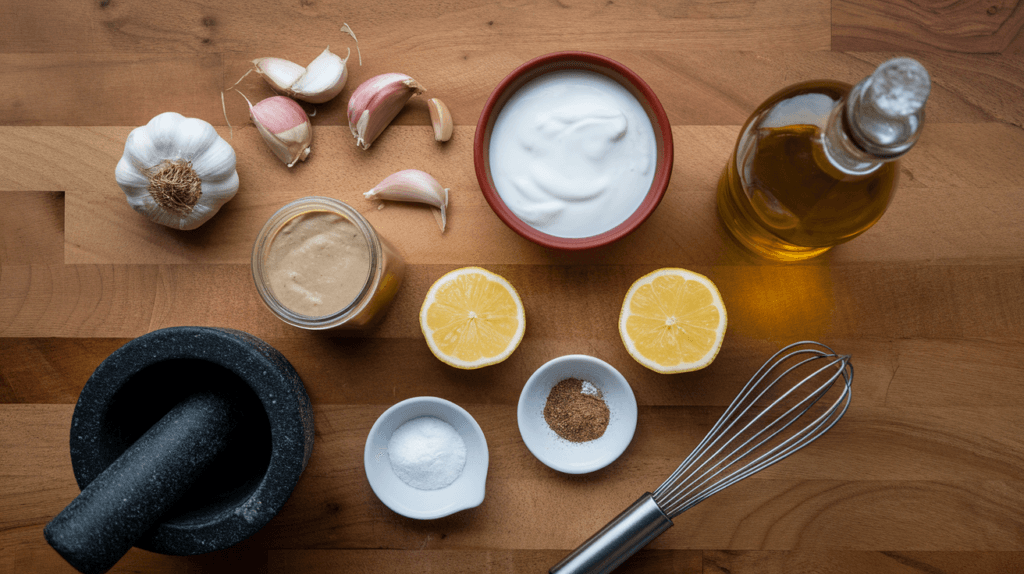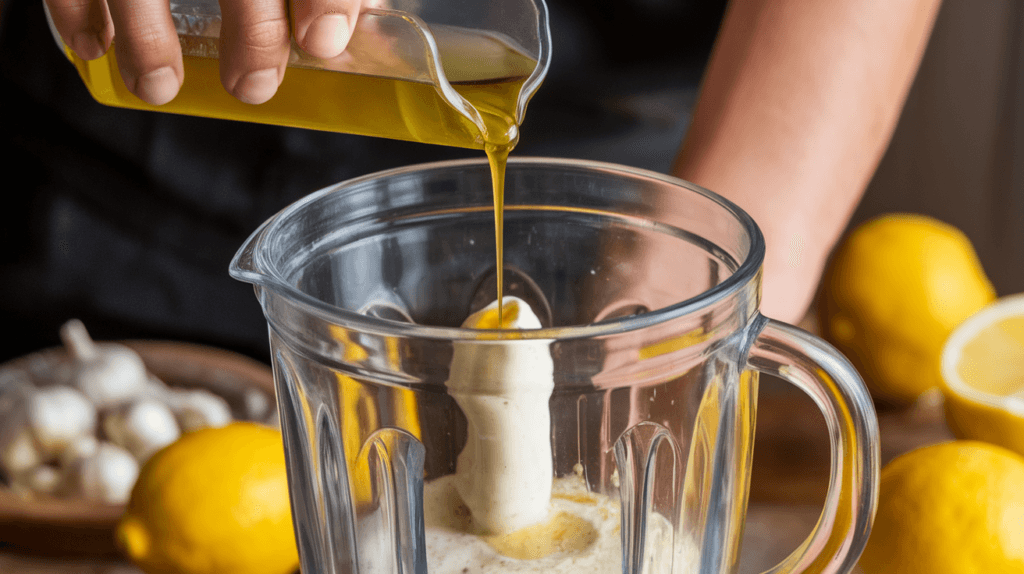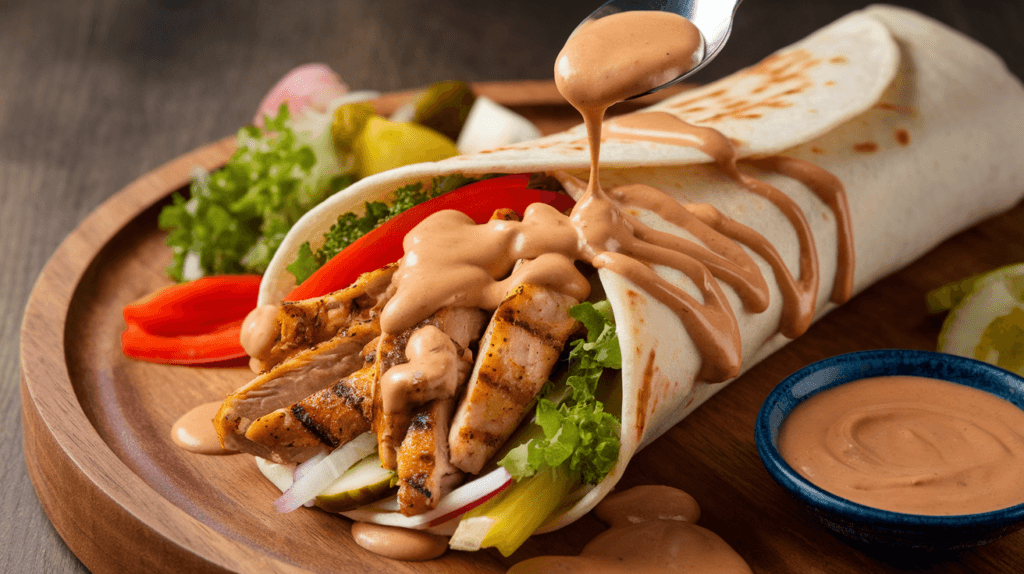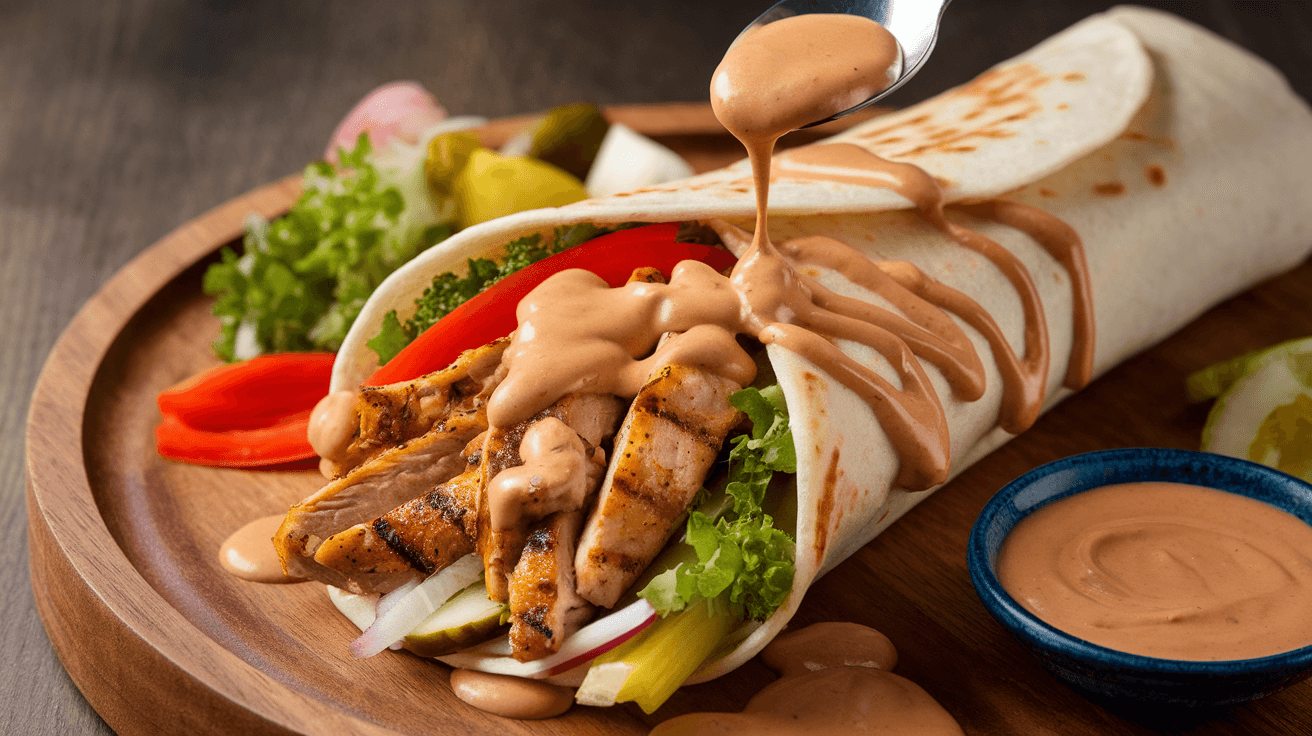Introduction

Shawarma sauce is the secret ingredient that elevates the taste of shawarma wraps, lending them their signature creamy, tangy, and flavorful profile. Whether you’re a fan of chicken, beef, orStep-by-Step Guide to M veggie shawarma, the sauce plays a vital role in enhancing every bite. But what exactly is shawarma sauce made of, and why does it taste so good?
This article dives into the components that make up this versatile condiment, exploring its different varieties, ingredients, and uses. By the end, you’ll have a clear understanding of what makes shawarma sauce so special and even learn how to make it yourself at home.
Main Ingredients of Shawarma Sauce
Base Ingredients
The foundation of shawarma sauce lies in its base, which provides its creamy texture and rich flavor. Common base ingredients include:
- Mayonnaise: Often used in modern recipes, it creates a smooth and rich texture.
- Yogurt: Adds a tangy, lighter touch, making it a healthier alternative.
- Tahini: A paste made from ground sesame seeds, offering a nutty flavor, especially in Middle Eastern versions.
Garlic as a Key Component
Garlic is the star of many shawarma sauces, particularly in traditional recipes like toum. Its pungent, spicy kick gives the sauce its signature sharpness. Depending on the recipe, garlic can be minced, mashed, or blended into a paste.
Tangy Elements
The tanginess of shawarma sauce comes from acidic ingredients like:
- Lemon Juice: Freshly squeezed lemon juice adds brightness and balance.
- Vinegar: Often included to intensify the tangy profile.
Spices and Seasonings
To round out the flavor, spices and seasonings are added to the sauce. Some popular choices include:
- Cumin: Adds a warm, earthy depth.
- Sumac: A Middle Eastern spice that contributes a tangy, citrus-like flavor.
- Salt and Pepper: Essential for enhancing the overall taste.
These ingredients combine to create a sauce that perfectly complements the savory and smoky notes of shawarma.
Types of Shawarma Sauce
Traditional Garlic Sauce (Toum)
Toum is a staple in many Middle Eastern cuisines and a classic accompaniment to shawarma. Made primarily from garlic, oil, lemon juice, and salt, this sauce is known for its bold, garlicky flavor and creamy texture. It’s prepared by emulsifying garlic and oil, much like mayonnaise, to achieve its fluffy consistency.
Yogurt-Based Sauce
A lighter alternative to toum, yogurt-based shawarma sauce is made by mixing yogurt with garlic, lemon juice, and a dash of olive oil. Sometimes, cucumber and mint are added for extra freshness, resembling a Middle Eastern take on tzatziki. This version pairs exceptionally well with chicken or veggie shawarma due to its refreshing profile.
Tahini-Based Sauce
Tahini-based shawarma sauce is a favorite in regions where tahini is a key ingredient in traditional cuisine. This sauce combines tahini, lemon juice, garlic, and water to create a creamy and nutty condiment. Some recipes may also include a hint of cumin or paprika for added depth of flavor.
Fusion Variations
Modern adaptations of shawarma sauce incorporate unique elements to cater to diverse palates. For instance:
- Spicy Shawarma Sauce: Includes chili flakes or hot sauce for a fiery kick.
- Herbed Sauce: Features fresh herbs like cilantro, parsley, or dill for an aromatic twist.
- Sweet and Tangy Sauce: A blend of honey or pomegranate molasses for a balanced sweet-and-sour flavor.
These variations demonstrate the versatility of shawarma sauce, making it a universally loved condiment.
Step-by-Step Guide to Making Shawarma Sauce
Traditional Garlic Sauce Recipe

Ingredients:
- 4-6 garlic cloves
- 1 cup vegetable oil (neutral flavor)
- 2 tablespoons fresh lemon juice
- 1/2 teaspoon salt
Instructions:
- Peel the garlic cloves and crush them into a paste using a mortar and pestle or food processor.
- Slowly add oil while blending, a little at a time, to create an emulsion.
- Alternate between adding oil and lemon juice until the mixture becomes thick and fluffy.
- Add salt to taste and mix well. Serve immediately or refrigerate.
Yogurt-Based Sauce Recipe
Ingredients:
- 1 cup plain Greek yogurt
- 1 garlic clove, minced
- 2 tablespoons lemon juice
- 1 tablespoon olive oil
- Salt to taste
Instructions:
- In a mixing bowl, whisk the yogurt until smooth.
- Add minced garlic, lemon juice, and olive oil. Stir until well combined.
- Season with salt to taste. Chill before serving for the best flavor.
Tahini-Based Sauce Recipe
Ingredients:
- 1/2 cup tahini
- 1/4 cup water (adjust for consistency)
- 2 tablespoons lemon juice
- 1 garlic clove, minced
- Pinch of cumin (optional)
Instructions:
- In a bowl, combine tahini and water, whisking until smooth.
- Mix in lemon juice, minced garlic, and cumin if desired.
- Adjust water for your preferred consistency and season with salt if needed.
Tips for Achieving the Perfect Texture
- Use Fresh Ingredients: Fresh garlic, yogurt, and tahini enhance the sauce’s flavor.
- Blend Thoroughly: Proper mixing ensures a smooth and creamy consistency.
- Balance the Flavors: Adjust lemon juice, garlic, and salt to suit your taste.
- Chill Before Serving: Let the sauce rest in the refrigerator to allow the flavors to meld.
With these recipes, you can recreate the magic of shawarma sauce in your own kitchen.
Health Benefits of Shawarma Sauce
Nutritional Value of Ingredients
Shawarma sauce isn’t just a delicious addition to your meal—it also offers several nutritional benefits, depending on the ingredients used. Here’s a breakdown of key components:
- Garlic: Known for its antibacterial and anti-inflammatory properties, garlic can boost your immune system and promote heart health.
- Yogurt: Rich in probiotics, calcium, and protein, yogurt-based sauces support gut health and bone strength.
- Tahini: Packed with healthy fats, vitamins, and minerals, tahini is a good source of energy and contributes to skin and hair health.
- Lemon Juice: High in vitamin C, lemon juice aids digestion and strengthens the immune system.
These ingredients make shawarma sauce a flavorful yet nutritious condiment when enjoyed in moderation.
Low-Calorie Options
If you’re watching your calorie intake, you can modify shawarma sauce recipes to create healthier versions:
- Use Greek Yogurt: Opt for non-fat or low-fat Greek yogurt instead of mayonnaise or full-fat yogurt.
- Reduce Oil: In garlic sauces like toum, reduce the amount of oil and replace some with a bit of water or aquafaba (chickpea water) to maintain the creamy texture.
- Add Fresh Herbs: Enhance flavor with fresh herbs like parsley or mint instead of extra salt or sugar.
These adjustments can make shawarma sauce a guilt-free indulgence while maintaining its delightful taste.
Potential Health Benefits of Regular Use
Including shawarma sauce in your meals can contribute to a balanced diet when paired with wholesome foods like lean meats, vegetables, and whole-grain wraps. The garlic and lemon juice in the sauce may aid digestion and metabolism, while yogurt or tahini provides a dose of essential nutrients.
With the right tweaks, the sauce can be a healthy and flavorful addition to your culinary repertoire.
How to Pair Shawarma Sauce
With Shawarma Wraps

The most common use of shawarma sauce is in wraps, where it complements the marinated and grilled meat. Whether it’s chicken, beef, lamb, or a vegetarian filling, the sauce provides a creamy and tangy contrast to the smoky and savory flavors of the shawarma. Spread a generous amount on flatbreads like pita or lavash, add your favorite protein, fresh vegetables, and pickles, then roll it up for a perfect bite.
With Salads and Appetizers
Shawarma sauce also shines as a dressing for salads and a dip for appetizers. Drizzle it over fresh greens, roasted vegetables, or grain-based salads like tabbouleh or couscous to enhance their flavor. It pairs equally well with fried or baked appetizers such as falafel, kibbeh, or even fries, offering a creamy complement to their crispy texture.
Creative Uses
Beyond its traditional pairings, shawarma sauce can be used creatively in various dishes:
- Pizza Topping: Use shawarma sauce as a drizzle on Middle Eastern-inspired pizzas with toppings like chicken, onions, and peppers.
- Sandwich Spread: Replace mayonnaise or mustard with the sauce for an exotic twist on your sandwiches or burgers.
- Marinade: Incorporate the sauce into marinades for grilled meats or roasted vegetables to infuse them with bold flavors.
Its versatility makes the sauce a must-have in any kitchen, allowing you to experiment with new and exciting ways to use it.
Regional Variations of Shawarma Sauce
Middle Eastern Variations
In the Middle East, shawarma sauce recipes can vary slightly depending on the country. For example:
- Lebanon: Garlic sauce, or toum, is the most popular choice, emphasizing the use of fresh garlic and olive oil.
- Syria: A tangy yogurt-based sauce with hints of cumin and parsley is a favorite.
- Jordan and Palestine: Tahini-based sauces with a touch of pomegranate molasses for sweetness are common.
Western Adaptations
As shawarma gained popularity worldwide, the sauce evolved to suit local palates. Western adaptations often include mayonnaise as the base for a milder flavor and a creamier texture. Additionally, fusion sauces, such as spicy mayo or avocado the sauce, have emerged in North America and Europe.
Indian and Pakistani Influences
In South Asia, the sauce often incorporates spices like garam masala, chili powder, or coriander to cater to the region’s love for bold, spicy flavors. Some variations may also include mint or green chilies for a refreshing heat.
North African Influences
In countries like Egypt, shawarma sauce may include a dash of harissa, a spicy chili paste, to add heat and depth. This variation pairs particularly well with lamb shawarma.
The adaptability of the sauce to different cultures and cuisines highlights its global appeal and enduring popularity.
Popular Dishes That Use Shawarma Sauce
Classic Shawarma Wraps
Shawarma sauce is most famously paired with shawarma wraps, where its creamy texture and bold flavor balance the smoky, marinated meats and crunchy vegetables. The sauce is spread generously inside the pita bread or flatbread, ensuring every bite is packed with flavor.
Shawarma Bowls
Shawarma bowls are a modern, deconstructed version of the wrap, featuring layers of rice or grains, seasoned meat, fresh veggies, and a generous drizzle of the sauce. The sauce ties all the components together, making it a standout element of the dish.
Falafel Plates
For vegetarians, the sauce is a perfect pairing with falafel. The creamy and garlicky notes of the sauce complement the crispy, herby falafel balls, whether served in wraps or as part of a mezze platter.
Grilled Vegetables
Grilled or roasted vegetables take on new life when paired with the sauce. The tangy and savory flavors of the sauce enhance the natural sweetness of vegetables like eggplant, zucchini, and bell peppers.
Shawarma Fries
A fusion favorite, shawarma fries combine crispy french fries with shawarma toppings like shredded meat, fresh herbs, pickled vegetables, and, of course, a generous drizzle of the sauce. This dish is a crowd-pleaser in street food and casual dining scenes.
These dishes demonstrate the versatility of shawarma sauce, making it a must-have for enhancing countless recipes beyond the traditional wrap.
FAQs
Is Shawarma Sauce Spicy?
the sauce is not typically spicy, but it can be customized with ingredients like chili flakes or hot sauce for those who prefer a spicy kick.
Can You Store Shawarma Sauce?
Yes, the sauce can be stored in an airtight container in the refrigerator for up to one week. Freshly made sauce is recommended for the best flavor.
What’s the Difference Between Shawarma Sauce and Tzatziki?
Shawarma sauce and tzatziki share similarities but are different. Tzatziki is a Greek sauce made with yogurt, cucumber, and dill, while the sauce varies and may include tahini, garlic, or mayonnaise.
Can It Be Made Vegan?
Absolutely! Vegan the sauce can be made using plant-based yogurt, tahini, or aquafaba as a base, ensuring no animal products are used.
What Are Common Mistakes in Making Shawarma Sauce?
Some common mistakes include over-blending the garlic (resulting in bitterness), adding oil too quickly (causing the emulsion to break), or not balancing the flavors properly.
Which Cuisine Popularized Shawarma Sauce?
Shawarma sauce is most closely associated with Middle Eastern cuisine, where it serves as a key accompaniment to the beloved shawarma dish.
Conclusion
Shawarma sauce is a delicious and versatile condiment that enhances the flavors of shawarma wraps, salads, and more. Whether you prefer the garlicky punch of traditional toum, the creamy tanginess of yogurt-based sauces, or the nutty richness of tahini-based varieties, there’s a the sauce for everyone.
With a few simple ingredients and recipes, you can recreate this iconic sauce at home, experimenting with flavors to suit your tastes. From its nutritional benefits to its countless uses, the sauce is a must-try for anyone looking to elevate their culinary game.

